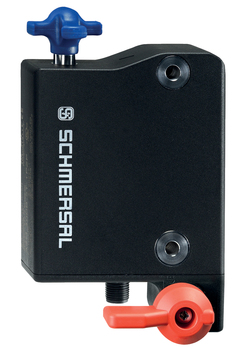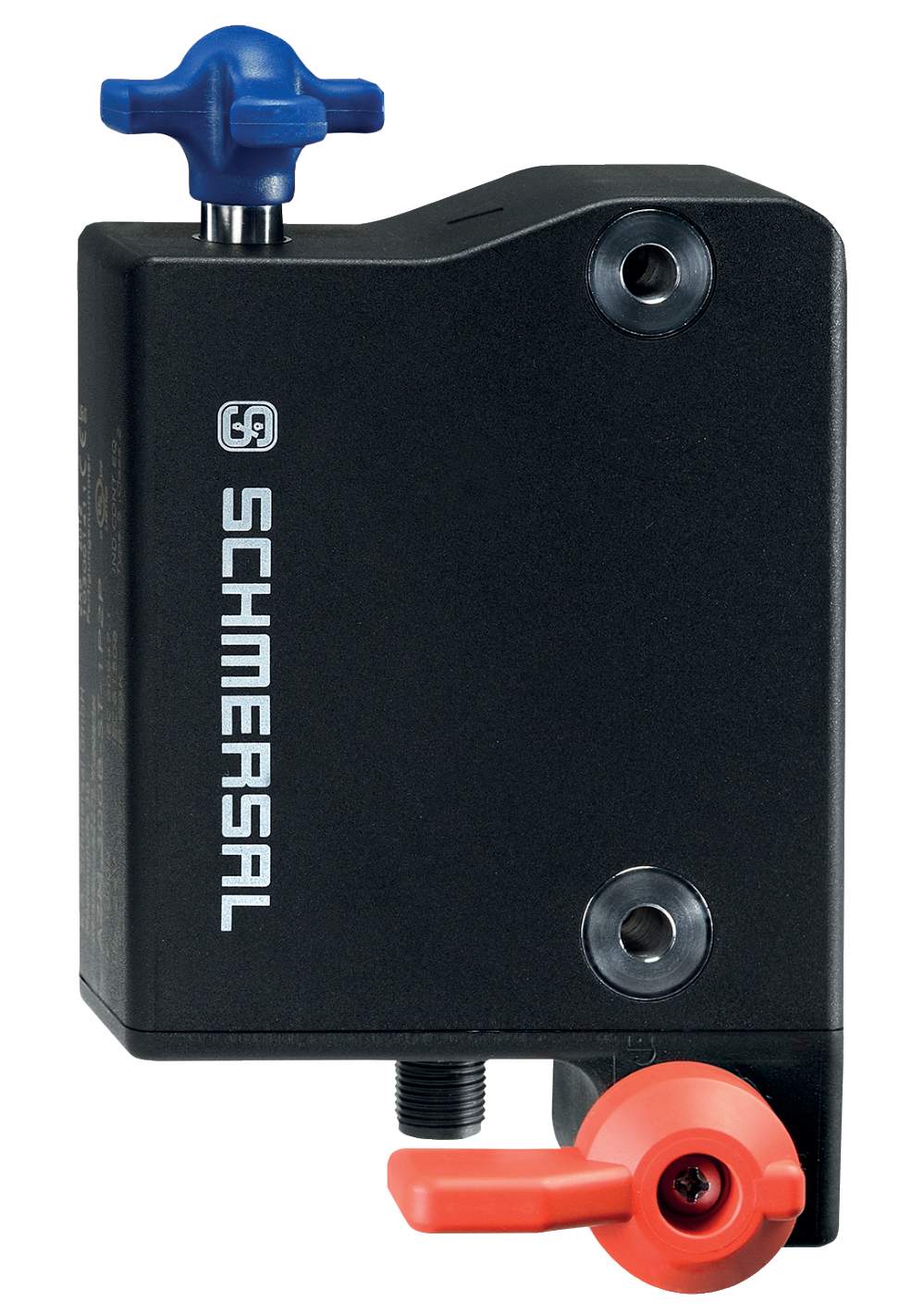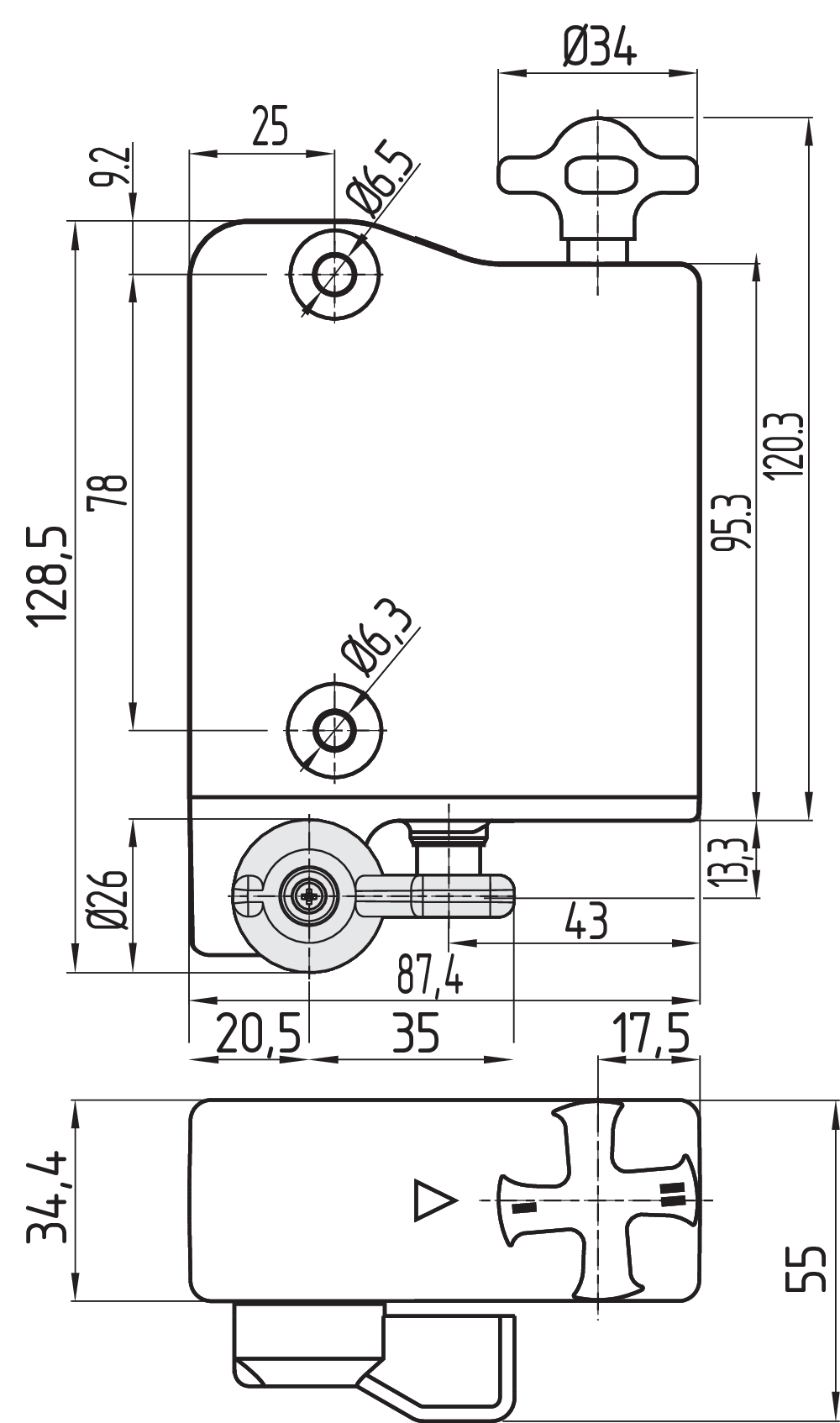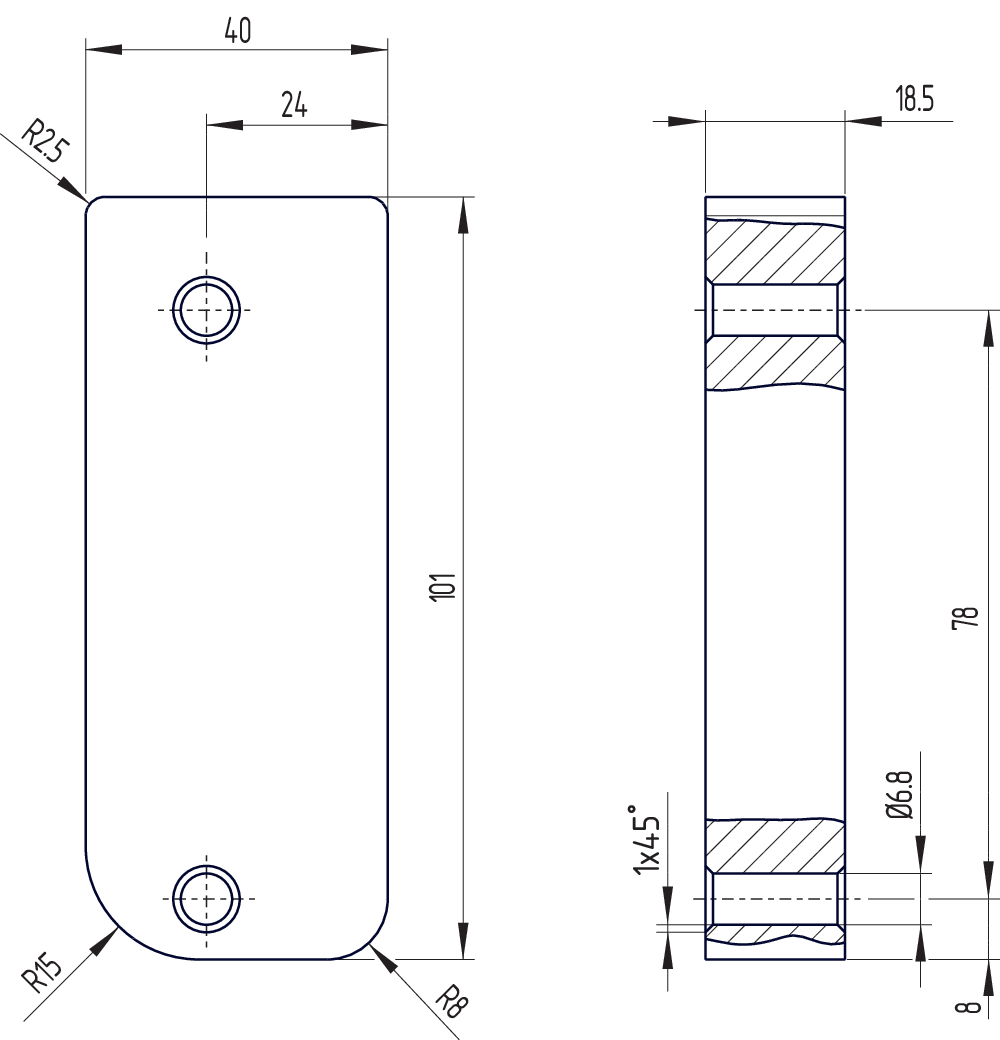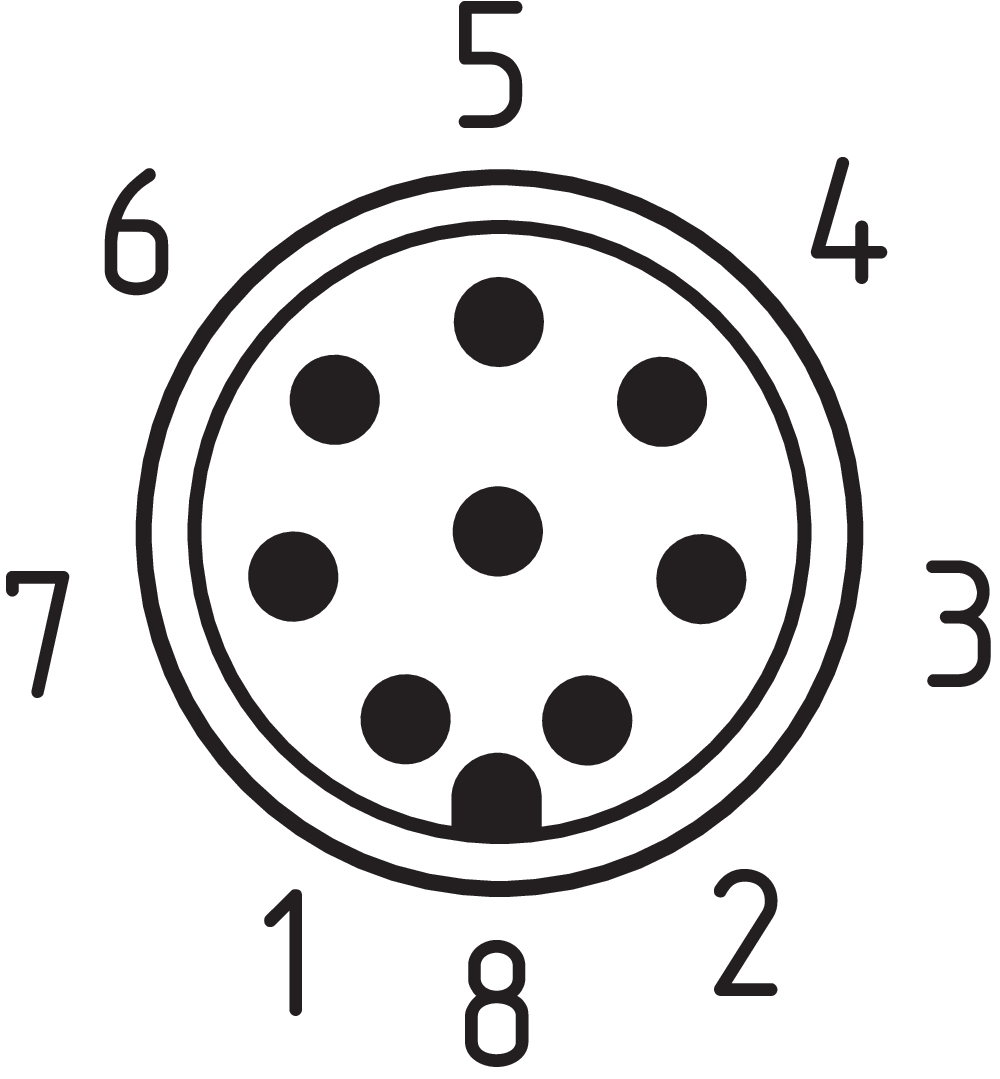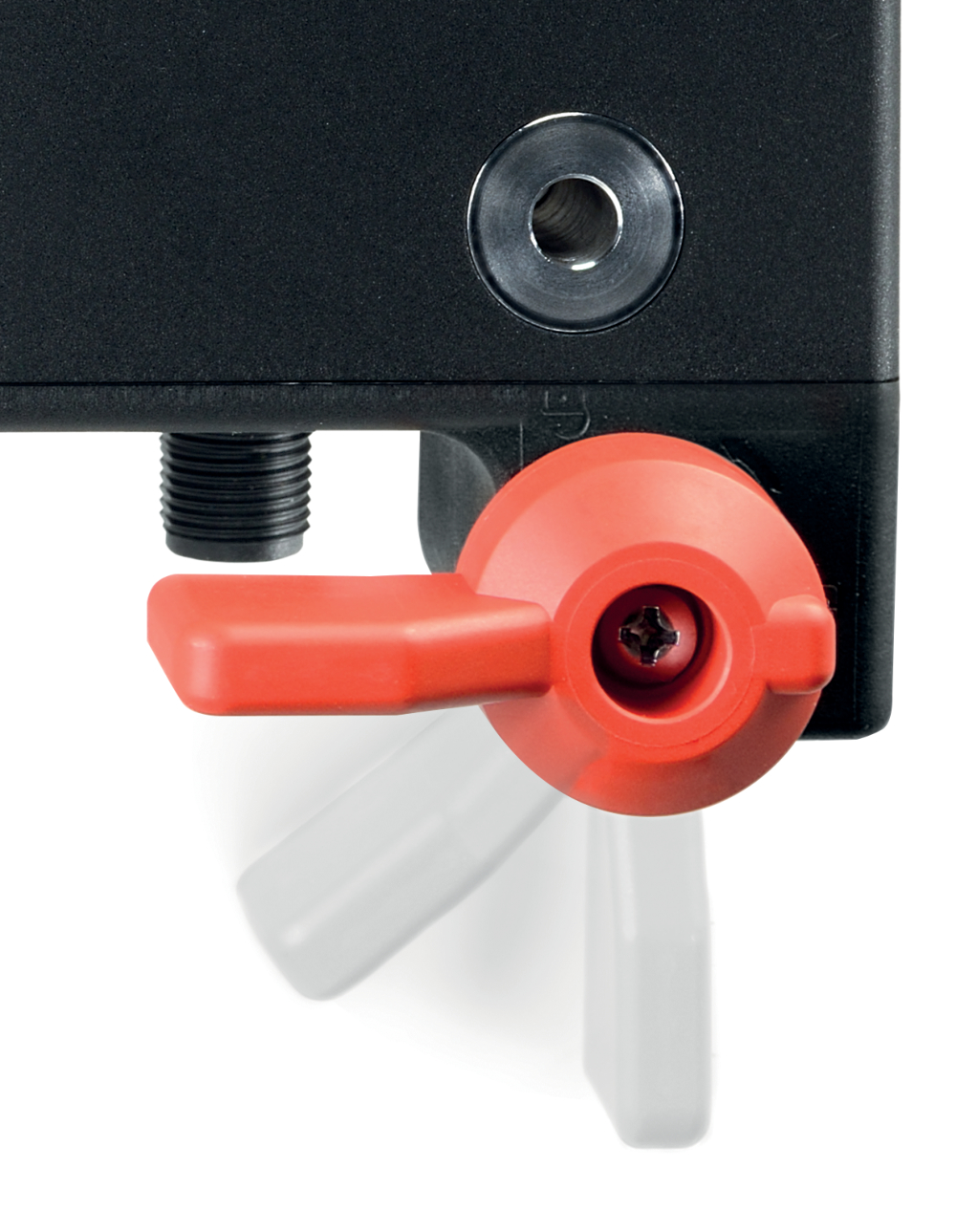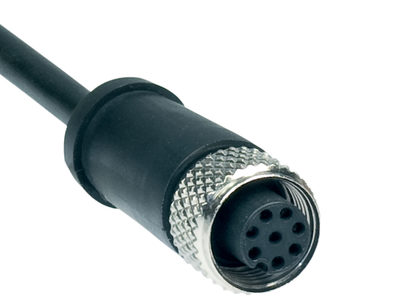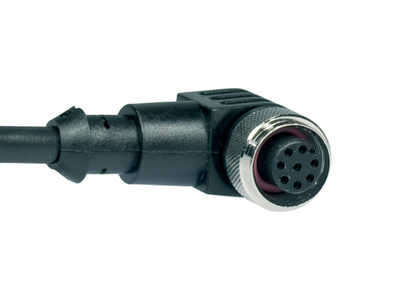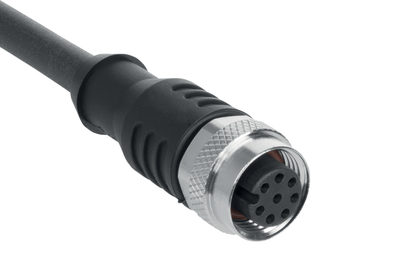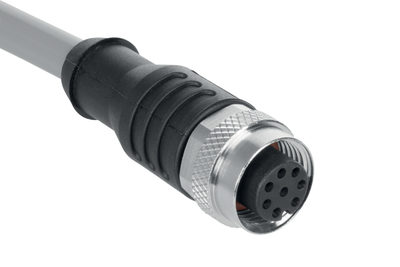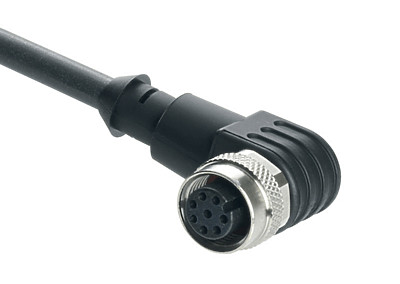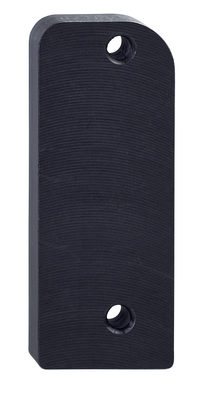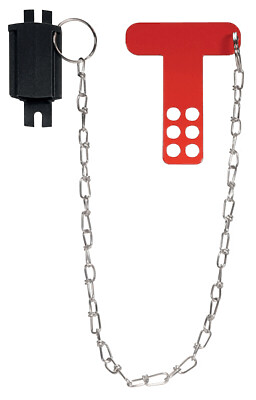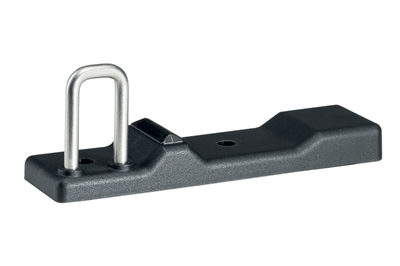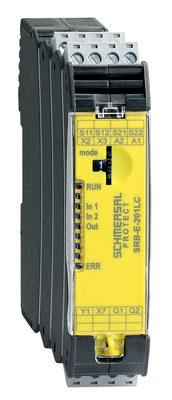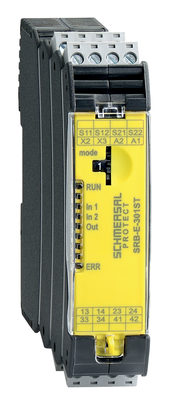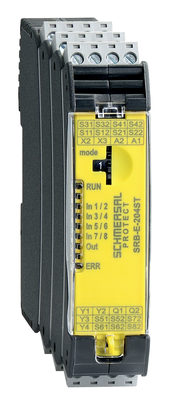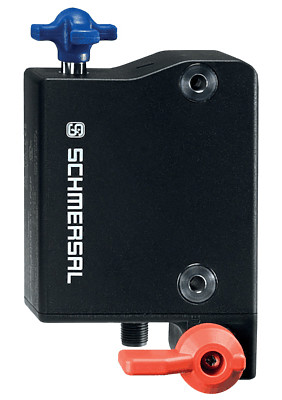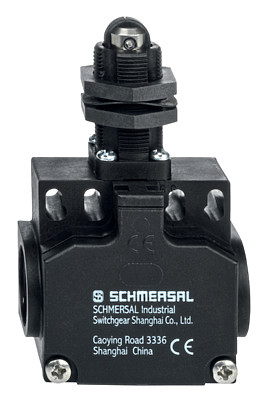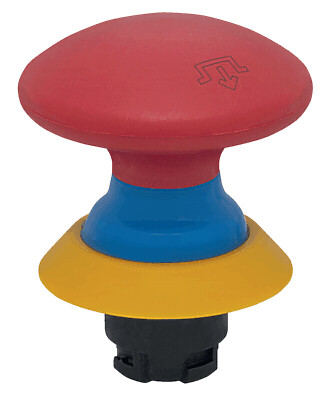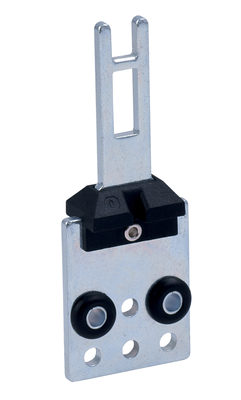AZM300Z-I2-ST-1P2P-N-DU
AZM300Z-I2-ST-1P2P-N-DU
- Multi-lærende indiciduel kodning med RFID-teknologi
- Kodningstrin HØJT ifølge ISO 14119
- Tilslutning M12, 8 polet
- Spænding for at åbne
- Beskyttelseslåsning overvåget
- Diagnoseudgang
- Nødstop tilbagestilling
- hygiejnerigtigt design
- Beskyttelses klasse IP69
- Egnet til montering på profilsystemer
- Kunstof hus
- Manipulationsbeskyttelse med RFID-teknologi, som dækker behovet
- 3 forskellige retninger af aktivering
- Kompakt design
- 3 Leds for at vise driftsforhold
- Passende til hængslede og glidende afskærmninger
- Serieforbundne
- Manuel reset
Bestillings data
| Tip (leveringsdygtighed) |
Leveres ikke længere! |
| Produkttypebetegnelse |
AZM300Z-I2-ST-1P2P-N-DU |
| Artikenummer (Bestillingsnummer) |
103046771 |
| EAN (European Article Number) |
4030661615783 |
| eCl@ss number, version 12.0 |
27-27-26-03 |
| eCl@ss number, version 11.0 |
27-27-26-03 |
| eCl@ss Nummer, Version 9.0 |
27-27-26-03 |
| ETIM number, version 7.0 |
EC002593 |
| ETIM number, version 6.0 |
EC002593 |
Godkendelser - Forskrifter
|
TÜV cULus ECOLAB FCC IC UKCA ANATEL |
Globale egenskaber
| Forskrifter |
EN ISO 13849-1 EN ISO 14119 EN IEC 60947-5-3 EN IEC 61508 |
| generel information |
Individuel kodning, flere lærbare |
| Kodningstrin ifølge EN ISO 14119 |
høj |
| Aktivt princip |
RFID |
| Frequency band RFID |
125 kHz |
| Transmitter output RFID, maximum |
-6 dBm |
| Materiale til kapsling |
Plastik, glass-fibre reinforced thermoplastic |
| Længde af risiko, maksimum |
200 ms |
| Aktuatorens reaktionstid, maksimum |
100 ms |
| Indgangens reaktionstid, maksimum |
1,5 ms |
| Bruttovægt |
610 g |
Generelle data - egenskaber
| Hvilestrømsprincip |
Ja |
| Beskyttelseslåsning overvåget |
Ja |
| Rest |
Ja |
| Nødstoptilbagestilling |
Ja |
| Kortslutningsregistrering |
Ja |
| Kortslutningsregistrering |
Ja |
| Serieforbundet |
Ja |
| Sikkerhedsfunktionerne |
Ja |
| Integreret display, status |
Ja |
| Antal aktiverende retninger |
3 |
| Antal afsikre digitale udgange |
2 |
Klassifikation
| At standardisere, Forskrifter |
EN ISO 13849-1 EN IEC 61508 |
Sikkerhedsanalyse - Låsefunktion
| Performance Level, til |
e |
| Kontrolkategori |
4 |
| PFH-værdi |
5,20 x 10⁻¹⁰ /h |
| PFD-værdi |
4,50 x 10⁻⁵ |
| Safety Integrity Level (SIL), egnet i |
3 |
| Brugstid |
20 År |
Sikkerhedsanalyse - Spærrefunktion
| Performance Level, til |
d |
| Kontrolkategori |
2 |
| PFH-værdi |
2,00 x 10⁻⁹ /h |
| PFD-værdi |
1,80 x 10⁻⁴ |
| Safety Integrity Level (SIL), egnet i |
2 |
| Brugstid |
20 År |
Mekaniske data
| Mekanisk levetid, minimum |
1.000.000 koblinger |
| Info (Mekanisk levetid) |
Ved anvendelse som dørstopper: > 50.000 koblinger (dørmasser ≤ 5 kg og aktiveringshastighed ≤ 0,5 m/s) |
| Angular misalignment between solenoid interlock and actuator, maximum |
2 ° |
| Låsestyrke til EN ISO 14119 |
1.150 N |
| Låsestyrke, maksimum |
1.500 N |
| Latching force, adjustable, position 1 |
25 N |
| Latching force, adjustable, position 2 |
50 N |
| Version af monteringsskruer |
2x M6 |
| Tightening torque of the fixing screws, minimum |
6 Nm |
| Til- |
7 Nm |
Mechanical data - Switching distances
| Switch distance, typical |
2 mm |
| Sikret afbryderdistance ON |
1 mm |
| Sikret afbryderdistance OFF |
20 mm |
| Note (switching distance) |
All switching distances in accordance EN IEC 60947-5-3 |
Mekaniske data - Tilslutning
| Length of sensor chain, maximum |
200 m |
| Note (length of the sensor chain) |
Cable length and cross-section change the voltage drop dependiing on the output current |
| Note (series-wiring) |
Unlimited number of devices, oberserve external line fusing, max. 31 devices in case of serial diagnostic SD |
| Tilslutning, Stik |
Forbindelse M12, 8-polet, A-kodet |
Mekaniske data - afmåling
| Længde på føler |
146 mm |
| Bredde på føler |
87,5 mm |
| Højde på føler |
55 mm |
Omgivende forhold
| Beskyttelses klasse |
IP66 IP67 IP69 |
| Ambient temperature |
+0 ... +60 °C |
| Storage and transport temperature |
-10 ... +90 °C |
| Relativ fugtighed, maksimum |
93 % |
| Bemærk (relativ fugtighed) |
ikke kondenserende ingen overisning |
| Vibrationsstabilitet iht. EN 60068-2-6 |
10 … 150 Hz, amplitude 0,35 mm |
| Modstand over for slag |
30 g / 11 ms |
| Beskyttelsestal |
III |
| Tilladt opstillingshøjde over NN, maksimum |
3.000 m |
Omgivende forhold - Isolationsparametre
| Isolations spænding |
32 VDC |
| Fastsat impulsmodstandsspænding |
0,8 kV |
| Overspændingskategori |
III |
| Grad af forurening iht. IEC/EN 60664-1 |
3 |
Elektrisk data
| Operating voltage |
24 VDC -15 % / +10 % |
| No-load supply current I0, typical |
100 mA |
| Current consumption with magnet ON, average |
200 mA |
| Current consumption with magnet ON, peak |
350 mA / 200 ms |
| Rated operating voltage |
24 VDC |
| Forsyningsstrøm |
800 mA |
| Betinget kortslutningsstrøm iht. EN 60947-5-1 {A} |
100 A |
| External wire and device fuse rating |
2 A gG |
| Forsinkelse, maksimal |
5.000 ms |
| Afbryderfrekvens, maksimum |
0,5 Hz |
| Utilisation category DC-12 |
24 VDC / 0,05 A |
| Elektriske data, maksimum |
2 A |
Elektrisk data - Solenoidkontrol IN
| Betegnelse, Magnetaktivering |
IN |
| Omkoblingstærskler til magnetindgange |
-3 V … 5 V (Low) 15 V … 30 V (High) |
| Strømforbrug ved 24V |
10 mA |
| Magnet switch-on time |
100 % |
| Test pulse duration, maximum |
5 ms |
| Test pulse interval, minimum |
40 ms |
| Klassificering ZVEI CB24I, sænkning |
C0 |
| Klassificering ZVEI CB24I, kilde |
C1 C2 C3 |
Elektrisk data - sikre digitale indgange
| Betegnelse, sikkerhedsindgange |
X1 and X2 |
| Omkoblingstærskler den sikkerhedsindgange |
−3 V … 5 V (Low) 15 V … 30 V (High) |
| Strømforbrug på sikkerhedsindgangene ved 24V |
5 mA |
| Test pulse duration, maximum |
1 ms |
| Test pulse interval, minimum |
100 ms |
| Klassificering ZVEI CB24I, sænkning |
C1 |
| Klassificering ZVEI CB24I, kilde |
C1 C2 C3 |
Elektrisk data - sikre digitale udgange
| Betegnelse, Sikkerhedsudgange |
Y1 og Y2 |
| Version |
kortslutningssikker, P-type |
| Spændingsfald Ud, maksimum |
2 V |
| Reststrøm |
0,5 mA |
| Spænding, brugskategori DC-12 |
24 VDC |
| Strøm, brugskategori DC-12 |
0,25 A |
| Spænding, brugskategori DC-13 |
24 VDC |
| Strøm, brugskategori DC-13 |
0,25 A |
| Test pulse interval, typical |
1000 ms |
| Test pulse duration, maximum |
0,5 ms |
| Klassificering ZVEI CB24I, kilde |
C2 |
| Klassificering ZVEI CB24I, sænkning |
C1 C2 |
Elektrisk data - diagnoseudgang
| Betegnelse, Diagnoseudgange |
OUT |
| Version |
kortslutningssikker, P-type |
| Spændingsfald Ud, maksimum |
2 V |
| Spænding, brugskategori DC-12 |
24 VDC |
| Strøm, brugskategori DC-12 |
0,05 A |
| Spænding, brugskategori DC-13 |
24 VDC |
| Strøm, brugskategori DC-13 |
0,05 A |
Tilstandsvisning
| Bemærk (LED-tilstandsvisning) |
Driftstilstand gul LED Fejl Funktionsforstyrrelse: rød LED Forsyningsspænding UB: grøn LED |
Pin-tildeling
| PIN 1 |
A1 Forsyningsspænding UB |
| PIN 2 |
X1 Sikkerhedsindgang 1 |
| PIN 3 |
A2 GND |
| PIN 4 |
Y1 Sikkerhedsudgange 1 |
| PIN 5 |
OUT Diagnoseudgang |
| PIN 6 |
X2 Sikkerhedsindgang 2 |
| PIN 7 |
Y2 Sikkerhedsudgange 2 |
| PIN 8 |
IN Solenoidekontrol |
Inkluderet
| Inkluderet |
Actuator must be ordered separately. |
Tilbehør
| Anbefalede (Aktuator) |
AZ/AZM300-B1 |
Bemærk
| Bemærk (generelt) |
For døre, som lukker tæt til ved dørrammen, kan der anvendes en ekstra montageplade MP-AZ/AZM300-1. Til glas- og polycarbonatdøre kan det valgbare monteringssæt MS-AZ/AZM300-B1-1 anvendes. Den frigivne beskyttelsesanordning kan låses igen, så længe aktuatorhovedet forbliver i sikkerhedspositionen. Sikkerhedsudgangene kobles atter til, og derfor er det ikke nødvendigt at åbne beskyttelsesanordningen. |
Sprog filter
Datablad
Driftsvejledning og EU-overensstemmelseserklæring (Short)
Driftsvejledning - (tillæg/kort vejledning)
UL-certifikat
ECOLAB-certifikat
FCC-Zertifikat
UKCA Certifikat
BG-testcertifikat
ANATEL certification
Brochure
SISTEMA-VDMA bibliotek/library
Hent sidste version af Adobe Reader
Produktbillede (katalogenkeltfoto)
Dimensionstegning, grundlæggende komponent
Dimensional tegning (diverse)
Kontaktarrangement
Ledningseksempel
Detaljefoto
Video ID: azm300-09
Video ID: azm300-01
Video ID: azm300-06
103006868 AZM300Z-I2-ST-1P2P-N
- Multi-lærende indiciduel kodning med RFID-teknologi
- Kodningstrin HØJT ifølge ISO 14119
- Tilslutning M12, 8 polet
- Spænding for at åbne
- Beskyttelseslåsning overvåget
- Diagnoseudgang
- Nødstop tilbagestilling
- hygiejnerigtigt design
- Beskyttelses klasse IP69
- Egnet til montering på profilsystemer
- Kunstof hus
- Manipulationsbeskyttelse med RFID-teknologi, som dækker behovet
- 3 forskellige retninger af aktivering
- Kompakt design
- 3 Leds for at vise driftsforhold
- Passende til hængslede og glidende afskærmninger
- Serieforbundne
- Manuel reset
Indholdsfortegnelse
- 1 Om dette dokument
- 1.1 Funktion
- 1.2 Driftsvejledningens målgruppe: autoriseret fagpersonale
- 1.3 Anvendte symboler
- 1.4 Tilsigtet anvendelse
- 1.5 Generelle sikkerhedshenvisninger
- 2 Produktbeskrivelse
- 2.1 Typenøgle
- 2.2 Specialudførelser
- 2.3 Bestemmelse og brug
- 2.4 Advarsel mod forkert brug
- 2.5 Fritagelse for ansvar
- 2.6 Tekniske data
- 3 Montering
- 3.1 Generel montageanvisning
- 3.2 Manuel reset
- 3.3 Nødfrakobling -T/-T8 eller Nødoplåsning -N
- 3.4 Montage med montageplade
- 3.5 Dimensioner
- 3.6 Aktuator og tilbehør
- 4 Elektrisk tilslutning
- 4.1 Generelle informationer til den elektriske tilslutning
- 4.2 Serielle diagnose -SD
- 4.3 Eksempler på tilslutning til serieforbindelse
- 4.4 Tilslutningsbelægning og tilbehør stikforbindelser
- 5 betjeningskodning låsekraftjustering
- 5.1 Betjeningskodning
- 5.2 Låsestyrkeindstilling
- 6 Aktivt princip og diagnosefunktioner
- 6.1 Aktivering af magneterne
- 6.2 Sikkerhedsudgangenes arbejdsmåde
- 6.3 Diagnose-LED'er
- 6.4 Sikkerhedsafbryder med lås med normal diagnoseudgang
- 6.5 Sikkerhedsafbryder med lås med seriel diagnosefunktion SD
- 7 Idriftsættelse og service
- 8 Demontage og bortskaffelse
- 8.1 Demontage
- 8.2 Bortskaffelse
1 Om dette dokument
1.1 Funktion
Det foreliggende dokument indeholder de nødvendige informationer om montering, idriftsættelse, sikker drift og afmontering af sikkerhedsafbryderen. Driftsvejledningen, der følger med apparatet, skal altid være tilgængelig og læselig.
1.2 Driftsvejledningens målgruppe: autoriseret fagpersonale
Alle arbejdsskridt, der beskrives i denne driftsvejledning, må kun udføres af uddannet fagpersonale der er autoriseret af systemoperatøren.
Du må kun installere udstyret og tage det i brug når du har læst og forstået betjeningsvejledningen og er bekendt med de gældende forskrifter vedrørende arbejdssikkerhed og forebyggelse af ulykker.
Valg og montering af udstyret samt den styringstekniske integrering forudsætter kvalificeret kendskab til de relevante love og maskinproducentens krav i henhold til standarder.
Uden ansvar for oplysningernes rigtighed. Vi forbeholder os ret til ændringer der tjener tekniske fremskridt.
1.3 Anvendte symboler
- Information, Tip, Anvisning: Dette symbol markerer nyttige supplerende informationer.
- Forsigtig: Hvis denne advarsel ikke overholdes, kan det medføre forstyrrelser eller fejlfunktioner.
Advarsel: Hvis denne advarsel ikke overholdes, kan det medføre en personskade og/eller skade på maskinen.
1.4 Tilsigtet anvendelse
Schmersals produktsortiment er ikke beregnet til private forbrugere.
De produkter der beskrives i nærværende vejledning, er udviklet til at overtage sikkerhedsmæssige funktioner som del af et samlet anlæg eller en samlet maskine. Producenten af et anlæg eller en maskine har ansvaret for at sikre funktionen i sin helhed.
Sikkerhedsafbryderen må udelukkende bruges i henhold til følgende forklaringer eller til de formål den er godkendt til af producenten. Du kan finde detaljerede oplysninger om anvendelsesområdet i kapitlet "Produktbeskrivelse".
1.5 Generelle sikkerhedshenvisninger
Sikkerhedsanvisningerne i betjeningsvejledningen samt nationale installations- og sikkerhedsregler samt forskrifter til forebyggelse af ulykker skal overholdes.
- Du kan finde yderligere tekniske informationer i Schmersal katalogerne eller i online-kataloget på internettet på products.schmersal.com.
2 Produktbeskrivelse
2.1 Typenøgle
| Produkttypebetegnelse: AZM300(1)-(2)-ST-(3)-(4)-(5) |
| (1) | |
| Z | Beskyttelseslåsning overvåget > |
| B | Aktuator overvåget |
| (2) | |
| uden | Standardkodning |
| I1 | Individuel kodning |
| I2 | Individuel kodning, flere lærbare |
| (3) | |
| 1P2P | 1 diagnoseudgange, p-type og 2 sikkerhedsudgange, p-type |
| SD2P | seriel diagnoseudgang og 2 sikkerhedsudgange, p-type |
| (4) | |
| uden | Spænding for at åbne |
| A | Spænding for at låse |
| (5) | |
| uden | Manuel reset |
| N | Nødstop tilbagestilling |
| T | Nødudgang |
| T 8 | Nødfrakobling, afstand 8,5 mm |
2.2 Specialudførelser
For specialudførelser der ikke er angivet i typenøglen, gælder de ovenfor og nedenfor anførte angivelser på tilsvarende vis i det omfang de stemmer overens med den standardmæssige udførelse.
2.3 Bestemmelse og brug
Den berøringsfri aktiverende, elektroniske sikkerhedssensor er dimensioneret til anvendelse i sikkerhedsstrømkredsløb og anvendes som positionsovervågning og blokering af bevægeligt sikkerhedsudstyr.
- Sikkerhedskontaktanordningerne er klassificeret i henhold til EN ISO 14119 som type 4-koblingsmekanismer. Versioner med individuel kodning er klassificeret som høj-kodet.
De forskellige apparatvarianter kan anvendes som sikkerhedsafbryder med låsefunktion eller som sikkerhedsafbryder med lås.
- Hvis der som resultat af risikoanalysen kræves en sikkert overvåget sikkerhedslås, skal der monteres en variant med låseovervågning, mærket med symbolet >.
For varianten (B) drejer det sig om en sikkerhedsafbryder med en låsefunktion for procesbeskyttelse.
Sikkerhedsfunktionen sørger for, at sikkerhedsudgangene kobles sikkert fra ved afspærring eller når sikkerhedsudstyret åbnes, og at sikkerhedsudgangene forbliver sikkert frakoblet, når sikkerhedsudstyret er åbnet eller blokeret.
- Eftersom beskyttelsesanordningen kan åbnes umiddelbart ved spændingssvigt eller aktivering af hovedafbryderen, må sikkerhedsafbryderne kun bruges i særtilfælde med arbejdsstrømsprincip efter streng vurdering af ulykkesrisikoen.
Etablering af en serieforbindelse er mulig. Ved serieforbindelse forbliver risikotiden uændret, og reaktionstiden øges med summen af den reaktionstid for indgangene pr. ekstra apparat, der er angivet i de tekniske data. Antallet af apparater er kun begrænset af den eksterne ledningsbeskyttelse iht. de tekniske data og ledningstab. En serieforbindelse af apparatvarianter med seriediagnose er mulig med op til 31 apparater.
- Bedømmelse og dimensionering af sikkerhedskæden skal udføres af brugeren i henhold til de relevante standarder og forskrifter og afhængigt af det krævede sikkerhedsniveau. Er der flere sikkerhedssensorer med i sikkerhedsfunktionen, skal PFH-værdierne for de enkelte komponenter lægges sammen.
- Den overordnede styring, som sikkerhedskomponenterne er forbundet med, valideres iht. relevante normer.
2.4 Advarsel mod forkert brug
- Ved usagkyndig brug eller anvendelse til andet end den tilsigtede anvendelse samt manipulationer kan der ved brug af sikkerhedsafbryderen ikke udelukkes farer for personer eller skader på maskin- eller anlægsdele. Når sikkerhedsanvisningerne samt anvisningerne vedrørende montage, idriftsættelse, drift og service overholdes, forekommer der så vidt vides ingen restrisici.
2.5 Fritagelse for ansvar
Vi påtager os intet ansvar for skader og driftsforstyrrelser, der opstår som følge af montagefejl eller tilsidesættelse af denne betjeningsvejledning. Producenten hæfter ikke ved skader, der opstår som følge af, at der benyttes reserve- eller tilbehørsdele, der ikke er godkendt af producenten.
Enhver form for reparationer, ombygninger og forandringer på egen hånd er ikke tilladt af sikkerhedsmæssige grunde og medfører, at producenten fralægger sig ansvaret for eventuelle skader, der opstår som følge heraf.
2.6 Tekniske data
Godkendelser - Forskrifter
|
TÜV cULus ECOLAB FCC IC UKCA ANATEL |
Globale egenskaber
| Forskrifter |
EN ISO 13849-1 EN ISO 14119 EN IEC 60947-5-3 EN IEC 61508 |
| generel information |
Individuel kodning, flere lærbare |
| Kodningstrin ifølge EN ISO 14119 |
høj |
| Aktivt princip |
RFID |
| Frequency band RFID |
125 kHz |
| Transmitter output RFID, maximum |
-6 dBm |
| Materiale til kapsling |
Plastik, glass-fibre reinforced thermoplastic |
| Længde af risiko, maksimum |
200 ms |
| Aktuatorens reaktionstid, maksimum |
100 ms |
| Indgangens reaktionstid, maksimum |
1,5 ms |
| Bruttovægt |
610 g |
Generelle data - egenskaber
| Hvilestrømsprincip |
Ja |
| Beskyttelseslåsning overvåget |
Ja |
| Rest |
Ja |
| Nødstoptilbagestilling |
Ja |
| Kortslutningsregistrering |
Ja |
| Kortslutningsregistrering |
Ja |
| Serieforbundet |
Ja |
| Sikkerhedsfunktionerne |
Ja |
| Integreret display, status |
Ja |
| Antal aktiverende retninger |
3 |
| Antal afsikre digitale udgange |
2 |
Klassifikation
| At standardisere, Forskrifter |
EN ISO 13849-1 EN IEC 61508 |
Sikkerhedsanalyse - Låsefunktion
| Performance Level, til |
e |
| Kontrolkategori |
4 |
| PFH-værdi |
5,20 x 10⁻¹⁰ /h |
| PFD-værdi |
4,50 x 10⁻⁵ |
| Safety Integrity Level (SIL), egnet i |
3 |
| Brugstid |
20 År |
Sikkerhedsanalyse - Spærrefunktion
| Performance Level, til |
d |
| Kontrolkategori |
2 |
| PFH-værdi |
2,00 x 10⁻⁹ /h |
| PFD-værdi |
1,80 x 10⁻⁴ |
| Safety Integrity Level (SIL), egnet i |
2 |
| Brugstid |
20 År |
Mekaniske data
| Mekanisk levetid, minimum |
1.000.000 koblinger |
| Info (Mekanisk levetid) |
Ved anvendelse som dørstopper: > 50.000 koblinger (dørmasser ≤ 5 kg og aktiveringshastighed ≤ 0,5 m/s) |
| Angular misalignment between solenoid interlock and actuator, maximum |
2 ° |
| Låsestyrke til EN ISO 14119 |
1.150 N |
| Låsestyrke, maksimum |
1.500 N |
| Latching force, adjustable, position 1 |
25 N |
| Latching force, adjustable, position 2 |
50 N |
| Version af monteringsskruer |
2x M6 |
| Tightening torque of the fixing screws, minimum |
6 Nm |
| Til- |
7 Nm |
Mechanical data - Switching distances
| Switch distance, typical |
2 mm |
| Sikret afbryderdistance ON |
1 mm |
| Sikret afbryderdistance OFF |
20 mm |
| Note (switching distance) |
All switching distances in accordance EN IEC 60947-5-3 |
Mekaniske data - Tilslutning
| Length of sensor chain, maximum |
200 m |
| Note (length of the sensor chain) |
Cable length and cross-section change the voltage drop dependiing on the output current |
| Note (series-wiring) |
Unlimited number of devices, oberserve external line fusing, max. 31 devices in case of serial diagnostic SD |
| Tilslutning, Stik |
Forbindelse M12, 8-polet, A-kodet |
Mekaniske data - afmåling
| Længde på føler |
146 mm |
| Bredde på føler |
87,5 mm |
| Højde på føler |
55 mm |
Omgivende forhold
| Beskyttelses klasse |
IP66 IP67 IP69 |
| Ambient temperature |
+0 ... +60 °C |
| Storage and transport temperature |
-10 ... +90 °C |
| Relativ fugtighed, maksimum |
93 % |
| Bemærk (relativ fugtighed) |
ikke kondenserende ingen overisning |
| Vibrationsstabilitet iht. EN 60068-2-6 |
10 … 150 Hz, amplitude 0,35 mm |
| Modstand over for slag |
30 g / 11 ms |
| Beskyttelsestal |
III |
| Tilladt opstillingshøjde over NN, maksimum |
3.000 m |
Omgivende forhold - Isolationsparametre
| Isolations spænding |
32 VDC |
| Fastsat impulsmodstandsspænding |
0,8 kV |
| Overspændingskategori |
III |
| Grad af forurening iht. IEC/EN 60664-1 |
3 |
Elektrisk data
| Operating voltage |
24 VDC -15 % / +10 % |
| No-load supply current I0, typical |
100 mA |
| Current consumption with magnet ON, average |
200 mA |
| Current consumption with magnet ON, peak |
350 mA / 200 ms |
| Rated operating voltage |
24 VDC |
| Forsyningsstrøm |
800 mA |
| Betinget kortslutningsstrøm iht. EN 60947-5-1 {A} |
100 A |
| External wire and device fuse rating |
2 A gG |
| Forsinkelse, maksimal |
5.000 ms |
| Afbryderfrekvens, maksimum |
0,5 Hz |
| Utilisation category DC-12 |
24 VDC / 0,05 A |
| Elektriske data, maksimum |
2 A |
Elektrisk data - Solenoidkontrol IN
| Betegnelse, Magnetaktivering |
IN |
| Omkoblingstærskler til magnetindgange |
-3 V … 5 V (Low) 15 V … 30 V (High) |
| Strømforbrug ved 24V |
10 mA |
| Magnet switch-on time |
100 % |
| Test pulse duration, maximum |
5 ms |
| Test pulse interval, minimum |
40 ms |
| Klassificering ZVEI CB24I, sænkning |
C0 |
| Klassificering ZVEI CB24I, kilde |
C1 C2 C3 |
Elektrisk data - sikre digitale indgange
| Betegnelse, sikkerhedsindgange |
X1 and X2 |
| Omkoblingstærskler den sikkerhedsindgange |
−3 V … 5 V (Low) 15 V … 30 V (High) |
| Strømforbrug på sikkerhedsindgangene ved 24V |
5 mA |
| Test pulse duration, maximum |
1 ms |
| Test pulse interval, minimum |
100 ms |
| Klassificering ZVEI CB24I, sænkning |
C1 |
| Klassificering ZVEI CB24I, kilde |
C1 C2 C3 |
Elektrisk data - sikre digitale udgange
| Betegnelse, Sikkerhedsudgange |
Y1 og Y2 |
| Version |
kortslutningssikker, P-type |
| Spændingsfald Ud, maksimum |
2 V |
| Reststrøm |
0,5 mA |
| Spænding, brugskategori DC-12 |
24 VDC |
| Strøm, brugskategori DC-12 |
0,25 A |
| Spænding, brugskategori DC-13 |
24 VDC |
| Strøm, brugskategori DC-13 |
0,25 A |
| Test pulse interval, typical |
1000 ms |
| Test pulse duration, maximum |
0,5 ms |
| Klassificering ZVEI CB24I, kilde |
C2 |
| Klassificering ZVEI CB24I, sænkning |
C1 C2 |
Elektrisk data - diagnoseudgang
| Betegnelse, Diagnoseudgange |
OUT |
| Version |
kortslutningssikker, P-type |
| Spændingsfald Ud, maksimum |
2 V |
| Spænding, brugskategori DC-12 |
24 VDC |
| Strøm, brugskategori DC-12 |
0,05 A |
| Spænding, brugskategori DC-13 |
24 VDC |
| Strøm, brugskategori DC-13 |
0,05 A |
Tilstandsvisning
| Bemærk (LED-tilstandsvisning) |
Driftstilstand gul LED Fejl Funktionsforstyrrelse: rød LED Forsyningsspænding UB: grøn LED |
Pin-tildeling
| PIN 1 |
A1 Forsyningsspænding UB |
| PIN 2 |
X1 Sikkerhedsindgang 1 |
| PIN 3 |
A2 GND |
| PIN 4 |
Y1 Sikkerhedsudgange 1 |
| PIN 5 |
OUT Diagnoseudgang |
| PIN 6 |
X2 Sikkerhedsindgang 2 |
| PIN 7 |
Y2 Sikkerhedsudgange 2 |
| PIN 8 |
IN Solenoidekontrol |
Hinweise zur Sicherheitsbetrachtung
- Sikkerhedsanalysen af låsefunktionen skal kun medtages for apparater med overvåget låsefunktion AZM300Z-…-1P2P-… (sml. typenøgler). En klassifikation for låsefunktionen til apparater med seriel diagnose "SD2P" er ikke tilladt på grund af det ikke-sikre låse-/frigivelsessignal via SD-gatewayen.
- Hvis en sikkerhedsafbryder med spænding for at åbne ikke kan monteres, kan en låsning med spænding for at låse anvendes i dette undtagelsestilfælde, når der foretages ekstra sikkerhedsforanstaltninger, der giver et lige så højt sikkerhedsniveau.
- Sikkerhedsanalysen af låsefunktionen er baseret på komponenterne Sikkerhedsafbryder med lås AZM på det totale anlæg.
Fra kundens side skal der træffes yderligere foranstaltninger, som for eksempel en sikrere styring og en sikrere ledningsføring, for at udelukke fejl.
Når der optræder en fejl, der resulterer i, at låsefunktionen frigives, registreres dette af sikkerhedsafbryderen med lås, og sikkerhedsudgangene Y1/Y2 afbryder på sikker vis. Når en sådan fejl forekommer, ville beskyttelsesanordningen umiddelbart kunne åbnes, før maskinens sikre tilstand var opnået. Kategori 2's systemfunktion tillader, at der mellem testene optræder en fejl, der giver tab af sikkerhedsfunktionen, og at tabet af sikkerhedsfunktionen registreres af testen.
- Styringen af låsefunktionen skal sammenlignes eksternt med OSSD-frigivelsen. Sker der her en frakobling på grund af utilsigtet afsikring, opfanges dette af den eksterne diagnose.
UL-info
- Dette apparat er beregnet til strømforsyning via en opstillet kilde med begrænset spænding, begrænset strøm eller klasse 2. Dette apparat skal forsynes over et opstillet (CYJV) kabel-/connektormodul med mindst 24 V jævnstrøm og 0,8 A.
FCC/IC - Bemærk
Dette apparat er overensstemmende med del 15 i FCC-bestemmelserne og indeholder licensfrie sendere/modtagere, som er overensstemmende med de licensfrie RSS-standarder ifølge ISED (Innovation, Science and Economic Development) Canada.
Driften er underlagt følgende to betingelser:
(1) Dette apparat må ikke fremkalde skadelige forstyrrende signaler, og
(2) Dette apparat skal kunne tolerere forstyrrende signaler. Herunder hører også forstyrrende signaler, der kan føre til, at apparatet har en uønsket funktionsmåde.
Dette apparat overholder ved drift med en minimumsafstand på 100 mm grænseværdierne for nervestimulation (ISED SPR-002). Ændringer eller tilpasninger, der ikke er blevet udtrykkeligt godkendt af K.A. Schmersal GmbH & Co. KG, kan føre til, at brugerens autorisation til at benytte apparatet bortfalder.
Den licensfrie sender/modtager, der er indeholdt i dette apparat, opfylder de for licensfrie trådløse apparater gældende krav ifølge „Radio Standards Specification", der er fastsat af myndigheden Innovation, Science and Economic Development Canada (ISED). Drift er tilladt under disse to forudsætninger:
(1) Apparatet må ikke frembringe forstyrrelser.
(2) Apparatet skal kunne modstå radiointerferens, også selv om denne vil kunne nedsætte apparatets funktionsevne.
Dette apparat opfylder kravene til eksponeringsgrænseværdier for nervestimulering (ISED CNR-102) ved processer med en mindsteafstand på 100 mm.
Ændringer eller ombygninger, der ikke udtrykkeligt er blevet godkendt af K.A. Schmersal GmbH & Co. KG, kan føre til, at brugerens autorisation til at benytte apparatet bortfalder.
 20941-22-14519 | Este equipamento nao tem direito àprotecao contra interferência prejudicial e nao pode causar interferencia em sistemas devidamente autorizados. Para maiores informacores consultar: www.gov.br/anatel |
3 Montering
3.1 Generel montageanvisning
- Overhold anvisningerne i standarderne EN ISO 12100, EN ISO 14119 og EN ISO 14120.
Der er to fastgørelseshuller til M6 skruer til fastgørelse af både sikkerhedsafbryderen med lås og af aktuatoren (tilspændingsmoment: 6 … 7 Nm).
Monteringspositionen kan frit vælges. Systemet må kun drives, når en vinkel på ≤ 2° opretholdes mellem låsen og aktuatoren.

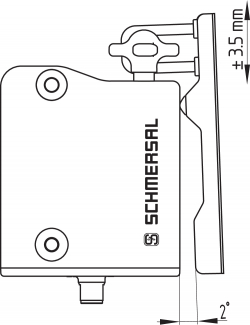
- Sikkerhedsafbryderen med lås skal ikke bruges som anslag. Afhængigt af dørmassen og aktiveringshastigheden kan den mekaniske levetid forringes noget.
Montering af aktuatormodulerne
Se monteringsvejledningen for det pågældende aktuatormodul.
- Aktuatoren skal monteres, så den ikke kan tages af, under overholdelse af korrekte foranstaltninger (anvendelse af engangsskruer, fastklæbning, udboring af skruehoveder, sikring med stift), på afskærmningen og sikres mod at forsyde sig.
Aktiveringsretninger


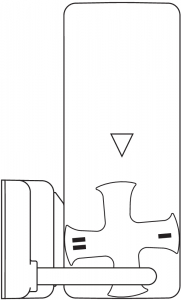
Illustrationerne viser en lukket beskyttelsesanordning ved en indstillet holdekraft på 50 N (se også kapitlet "Holdekraftindstilling").
- Sørg for, at aktuatoren går i hak i krydsgrebet.
Rigtigt

Forkert
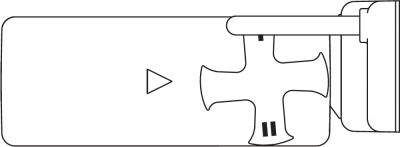
For at undgå at systemet påvirker og reducerer koblingsafstandene, skal følgende henvisninger overholdes:
- Metaldele i nærheden af sikkerhedsafbryderen kan påvirke koblingsafstanden.
- Fjern metalspåner
Minimumsafstanden mellem to sikkerhedsafbrydere
eller til andre systemer med samme frekvens (125 kHz)

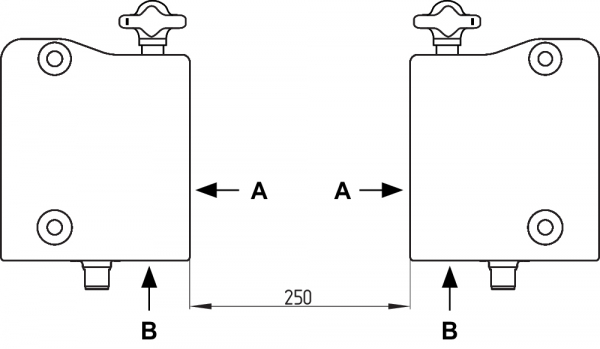
Mindsteafstanden for metalliske monteringsflader til forsiden "A" og til undersiden "B" på anordningen er 5 mm.


3.2 Manuel reset
Til opstilling af maskinen kan sikkerhedsafbryderen frakobles spændingsfrit. Drejes hjælpefrakoblingen i stilling q, frakolbes sikkerhedsafbryderen med lås. Når hjælpefrakoblingen drejes tilbage til udgangsposition p, fungerer systemet igen som normalt.
OBS: Drej ikke ud over anslaget!

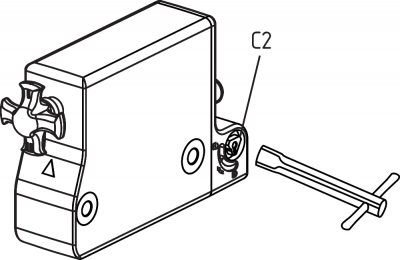
Tegnforklaring
A: Indbygningsstik M12, 8-polet
B: LED-visning
C1: Manuel reset vha. flad skruetrækker
C2: Manuel reset vha. trekantnøgle TK-M5
Den manuelle reset skal beskyttes mod utilsigtet aktivering, f.eks. ved anvendelse af vedlagte segl sættes på, efter vellykket idriftsættelse.
3.3 Nødfrakobling -T/-T8 eller Nødoplåsning -N
Ved varianterne med nødfrakobling og nødstop ligger det røde håndtag løst med. Håndtaget skal inden første idriftsættelse monteres på nødstoppets trekant med vedlagte skrue, så pilen i trekanten og det rød håndtags tap er ud for hinanden.
Monteringen af håndtaget kan ske fra begge sider. Den modsatte side kan benyttes som manuel reset ved hjælp af triangulær nøgle TK-M5.
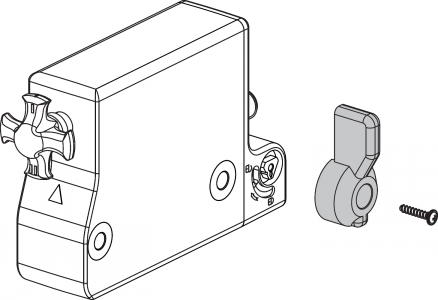
- Reset af den manuelle spærring ved at aktivere det røde nødoplåsningshåndtag på anden vis skal udelukkes.
- Nødfrakobling (-T/-T8)
montering og aktivering kun inden for fareområdet
Til nødfrakoblingen skal det røde håndtag drejes helt i pilens retning. Sikkerhedsudgangene slås fra, og beskyttelsesanordningen kan åbnes. Spærrestillingen ophæves ved at dreje håndtaget i den modsatte retning. Afskærmningen er sikret mod utilsigtet låsning i en afsikret position.
- Nødoplåsning (-N)
Montering og aktivering kun uden for fareområdet. Nødstoptilbagestillingen skal kun benyttes i nødstilfælde. Sikkerhedsafbryderen med lås skal anbringes og/eller således beskyttes, at en utilsigtet åbning af afbryderen undgås i kraft af nødstoptilbagestillingen. Nødstoptilbagestillingen skal være tydeligt mærket med en anvisning om, at den kun må benyttes i nødstilfælde. Til formålet kan vedlagte klæbemærkat anvendes.
Til nødoplåsning skal det røde håndtag drejes helt i pilens retning. Sikkerhedsudgangene slås fra, og beskyttelsesanordningen kan åbnes. Håndtaget er i indgreb og kan ikke drejes tilbage. For at ophæve spærrestillingen skal den midterste fastgørelsesskrue kun drejes så meget ud, at spærrestillingen er ophævet. Drej håndtaget tilbage og stram skruen igen.
- For at kunne yde en korrekt funktion på nødfrakoblingen -T/-T8 og på nødstoppet må beskyttelsesdøren ikke befinde sig i en mekanisk spændt tilstand.
- Kombinationen med en nødfrakobling og en nødoplåsning er mulig. Her skal man være opmærksom på at, når det røde håndtag aktiveres, drejer det modsatte håndtag med. Derfor er den oven for beskrevne fremgangsmåde nødvendig for at ophæve låsningen af nødhjælpsspærrestillingen.
3.4 Montage med montageplade
For døre, som lukker tæt til ved dørrammen, kan der anvendes en ekstra montageplade MP-AZ/AZM300-1.

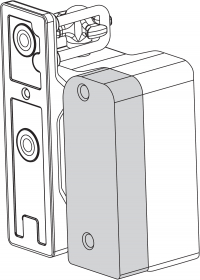
3.5 Dimensioner
Alle mål i mm.

AZM300...-T/-T8 eller -N
Anordninger med nødfrakobling eller nødoplåsning
Nødoplåsning -T / Nødfrakobling -N
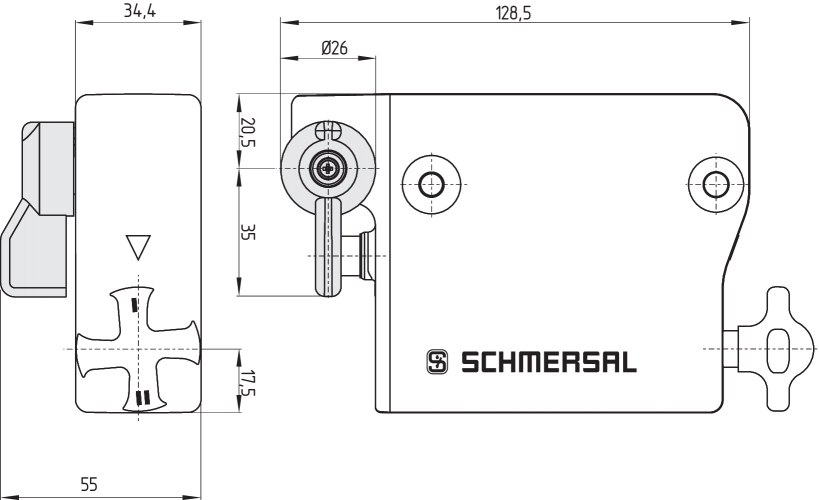
Nødfrakobling -T8

3.6 Aktuator og tilbehør
Aktuator AZ/AZM300-B1 (ikke med ved leveringen).
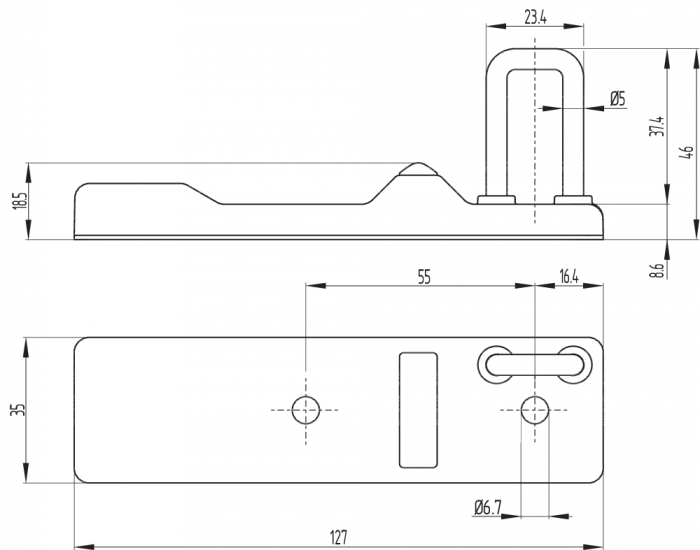
Montageplade MP-AZ/AZM300-1 (fås som tilbehør)

MS-AZ/AZM300-B1-1 (fås som tilbehør)
Beskyttelsesplade af aluminium som afskæmningsprofil til brug på glas- og kunststofdøre på maskiner, hvor der stilles høje krav til designet.
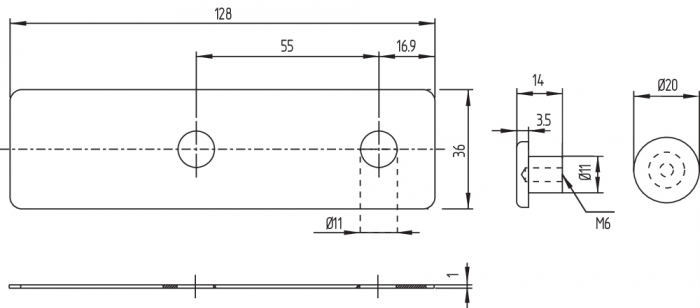
Spærringsmærke SZ 200-1 (fås som tilbehør)

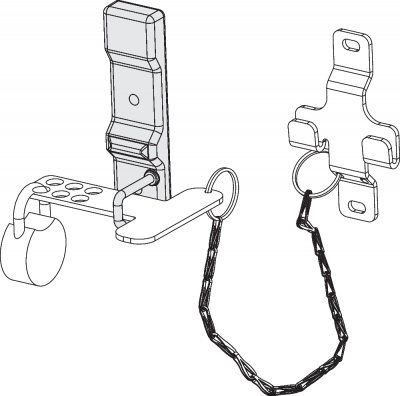
Kontrolkabeloplåsningstilbehøret ACC-AZM300-BOW-.-.M-.M (fås som tilbehør)
De yderligere anvisninger i betjeningsvejledningen for kontrolkabeloplåsning skal overholdes.

4 Elektrisk tilslutning
4.1 Generelle informationer til den elektriske tilslutning
- Den elektriske tilslutning må kun udføres i spændingsfri tilstand og af uddannet fagpersonale. Der
Spændingsindgangene A1, X1, X2 og IN skal beskyttes mod permanent overspænding. Derfor skal der anvendes PELV-forsyninger iht. EN 60204-1.
Der skal tages højde for den krævede elektriske ledningssikring i installationen.
Sikkerhedsudgangene kan anvendes direkte til kobling i brugerstyringens sikkerhedsrelevante del.
Krav til en efterkoblet måling:
To-kanalet sikkerhedsindgang, egnet til 2p-type halvlederudgange
- Konfiguration sikkerhedsstyring
Der bør indstilles en diskrepanstid på 100 ms, når en sikkerhedssensor tilsluttes elektroniske sikkerhedsanalyser. Analysens sikkerhedsindgange bør kunne skjule en testimpuls på ca. 1 ms. Der kræves ingen kortslutningsregistrering under målingen og den skal evt. deaktiveres.
- Du kan finde yderligere informationer om valget af egnede sikkerhedsanalyser i Schmersal-katalogerne eller i onlinekataloget på internettet på products.schmersal.com.
4.2 Serielle diagnose -SD
Kabeldimensionering
Kablet, som er tilsluttet en sikkerhedsafbryder med lås med seriel diagnosefunktion, må ikke overskride en kabelkapacitet på 50 nF. Normale uisolerede styreledninger LIVY 0,25 mm² til 1,5 mm² har ved 30 m længde en ledningskapacitet på ca. 3 … 7 nF afhængigt af kablets opbygning. 7 nF.
- Kontroller for spændingsfald i ledningerne samt de enkelte komponenters strømbelastningsevne under SD-apparaternes trådføring.
- Tilbehør til serieforbindelsen
SD-fordelerne PFB-SD-4M12-SD (varianter til fieldniveauet) og PDM-SD-4CC-SD (varianter til kontaktskab, kan skubbes på en montageskinne) samt andet omfangsrigt tilbehør sørger for en nem trådføring og serieforbindelse af SD-apparaterne. Detaljeret information på internettet på products.schmersal.com.
4.3 Eksempler på tilslutning til serieforbindelse
Der kan opbygges en serieforbindelse. Ved serieforbindelse forbliver risikotiden uændret, og reaktionstiden øges med summen af den reaktionstid for indgangene pr. ekstra apparat, der er angivet i de tekniske data. Antallet af apparater er kun begrænset af den eksterne ledningsbeskyttelse iht. de tekniske data og ledningstab. En serieforbindelse af AZM300 … SD med seriediagnose er mulig med op til 31 apparater.
De afbildede applikationseksempler er forslag, der ikke fritager brugeren for omhyggeligt at kontrollere koblingen mht. dens egnethed i de enkelte tilfælde.
Tilslutningseksempel 1: Serieforbindelse AZM300 med en normal diagnoseudgang
Spændingen tilføres begge sikkerhedsindgange i den sidste sikkerhedsafbryder i kæden (set fra analysen). Sikkerhedsudgangene på den første sikkerhedsafbryder føres til analysen.
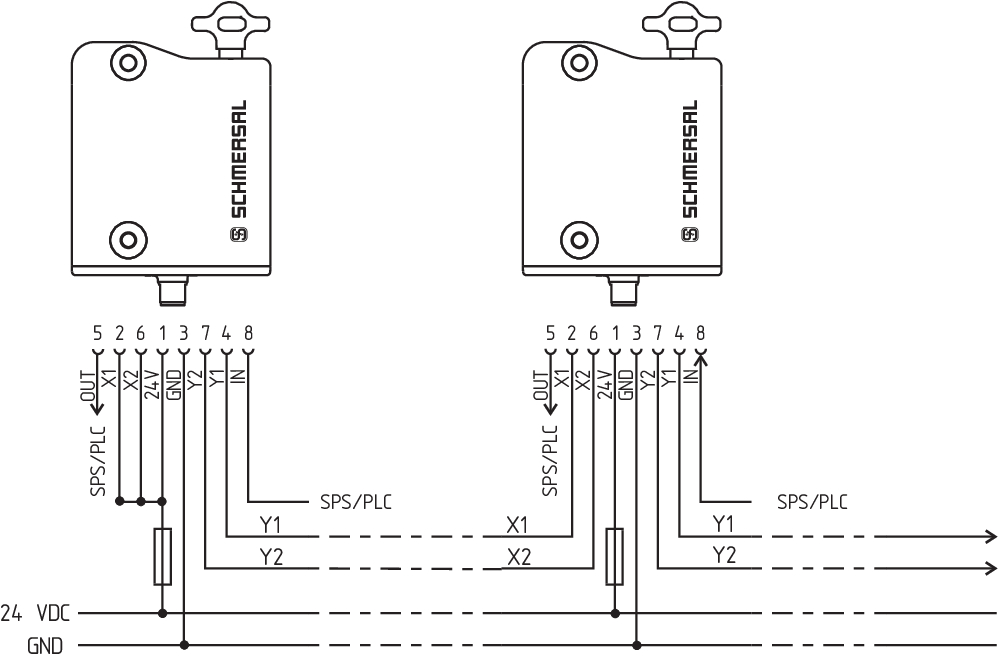
Y1 og Y2 = Sikkerhedsudgange → Analyse
Tilslutningseksempel 2: Serieforbindelse AZM300 med seriel diagnosefunktion (maks. 31 apparater i serie)
På apparater med en seriel diagnosefunktion (bestillingsindeks -SD) serieforbindes de serielle diagnosetilslutninger og ledes til en SD-gateway til en analyse. Sikkerhedsudgangene på den første sikkerhedsafbryder føres til analysen. Den serielle diagnose-gateway forbindes med den serielle diagnoseindgang på den første sikkerhedsafbryder.
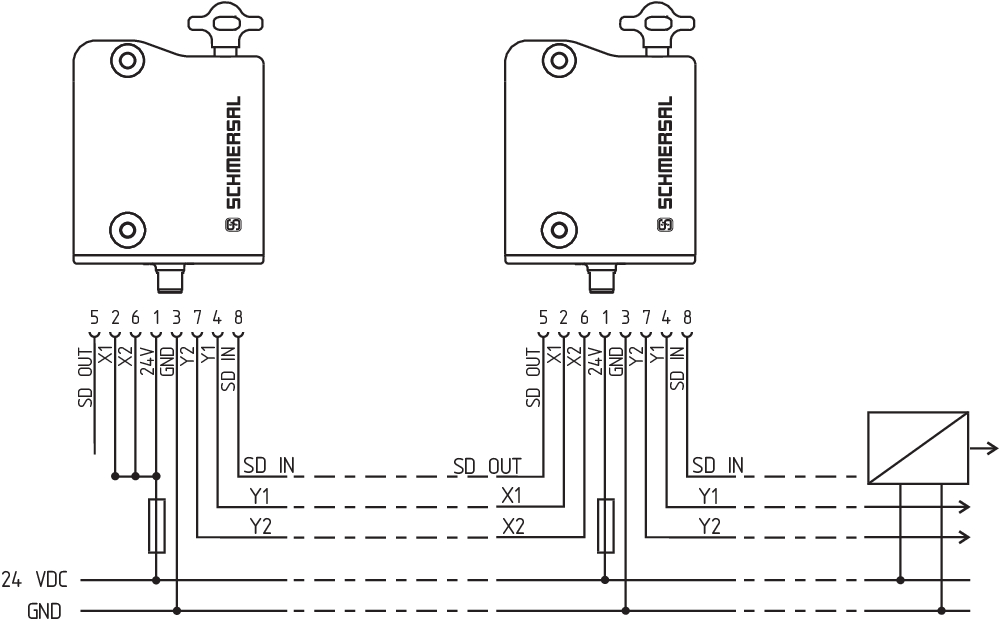
Y1 og Y2 = Sikkerhedsudgange → Analyse
SD-IN → Gateway → Fieldbus
4.4 Tilslutningsbelægning og tilbehør stikforbindelser
| Sikkerhedsafbryderens funktion | Stikkets pinkonfiguration | Farvekode for Schmersal-stikforbindelser | Evt. Mul. farvekode for yderligere gængse stikforbindelser iht EN-60947-5-2 | |||
|---|---|---|---|---|---|---|
| med konventionel diagnoseudgang | med seriel diagnosefunktion |  | IP67 / IP69 iht. DIN 47100 | IP69 (PVC) | ||
| A1 | Ue | 1 | WH | BN | BN | |
| X1 | Sikkerhedsindgang 1 | 2 | BN | WH | WH | |
| A2 | GND | 3 | GN | BU | BU | |
| Y1 | Sikkerhedsudgang 1 | 4 | YE | BK | BK | |
| OUT | Diagnoseudgang | SD udgang | 5 | GY | GY | GY |
| X2 | Sikkerhedsindgang 2 | 6 | PK | VT | PK | |
| Y2 | Sikkerhedsudgang 2 | 7 | BU | RD | VT | |
| IN | Magnetkontrol | SD-indgang | 8 | RD | PK | OR |
Afvigende pin-konfiguration ved brug af Y-splitter CSS-Y-8P til tilslutning til SD-gatewayen.
| Signal | PIN | Stik (2) | Lederfarver på | |||
|---|---|---|---|---|---|---|
| SCHMERSAL- ledning | Ledning iht. EN 60947-5-2 | Ledning iht. DIN 47100 | ||||
| A1 | 1 | Ue | BN | BN | WH |  |
| A1 | 2 | Ue | WH | WH | BN | |
| A2 | 3 | GND | BU | BU | GN | |
| A2 | 4 | GND | BK | BK | YE | |
| Y1 | 5 | Sikkerhedsudgang 1 | GY | GY | GY | |
| Y2 | 6 | Sikkerhedsudgang 2 | VT | PK | PK | |
| IN | 7 | SD-indgang | RD | VT | BU | |
| OUT | 8 | SD udgang | PK | OR | RD | |
| Tilslutningsledninger (PUR) med kobling (hun) IP67 / IP69, M12, 8-polig - 8 x 0,25 mm² iht. DIN 47100 | |
|---|---|
| Kabel længde | Bestillingsnummer |
| 2,5 m | 103011415 |
| 5,0 m | 103007358 |
| 10,0 m | 103007359 |
| 15,0 m | 103011414 |
| Tilslutningsledninger (PVC) med bøsning (hun) M12, 8-polet - 8 x 0,21 mm², IP69 | |
|---|---|
| Kabellængde | Bestillingsnummer |
| 5,0 m | 101210560 |
| 5,0 m, vinklet | 101210561 |
| 10,0 m | 103001389 |
| 15,0 m | 103014823 |
5 betjeningskodning låsekraftjustering
5.1 Betjeningskodning
Standardkodede sikkerhedsafbrydere med lås er klar til drift efter leveringen.
Individuelt kodede sikkerhedsafbrydere med lås og aktuatorer indlæses efter hinanden efter følgende skema:
- Sluk for sikkerhedsafbryderen med lås, og påtryk så igen spændingen.
- Placer aktuatoren i registreringsområdet. Indlæringen indikeres på sikkerhedsafbryderen med lås, den grønne LED slukker, den røde LED lyser, den gule LED blinker (1 Hz).
- Efter 10 sekunder kræver korte blinkimpulser (3 Hz), at driftsspændingen til sikkerhedsafbryderen med lås kobles fra. (Kobles der ikke fra inden for 5 minutter, afbryder sikkerhedsafbryderen med lås indlæringen, og melder en forkert aktuator med 5 gange rødt blinken).
- Når driftsspændingen slås til igen, skal aktuatoren igen registreres, for at aktivere den indlærte aktuatorkode. Den aktiverede kode lagres så endegyldigt.
Ved bestillingsoption -I1 kan den udførte tilordning af sikkerhedsafbryder og aktuator ikke ændres.
Ved bestillingsoption -I2 kan indlæringen af en ny aktuator gentages et begrænset antal gange. Indlæres en ny aktuator, bliver den gamle kode ugyldig. Derefter sikrer en frigivelsesspærring på ti minutter en øget beskyttelse mod manipulationer. Den grønne LED blinker, indtil frigivelsesspærringens tid er udløbet, og den nye aktuator blev registreret. Afbrydes spændingen under denne tid, genstarter beskyttelsen mod manipulationer på 10 minutter derefter.
5.2 Låsestyrkeindstilling
Skal apparatet fungere korrekt, skal krydsgrebet stå i stilling I eller II, når beskyttelsesanordningen er åbnet. Spærring er ikke mulig i mellemstillinger. Holdekraften ændres ved at dreje krydsgrebet 180°.
I stilling I udgør holdekraften ca. 25 N.
I stilling II udgør holdekraften ca. 50 N.

6 Aktivt princip og diagnosefunktioner
6.1 Aktivering af magneterne
På hvilestrømsvarianten for AZM300 er skærmlåsen afspærret, når IN signalet sættes under driften (= 24 V). På arbejdsstrømvarianten for AZM300 er skærmlåsen spærret, når IN signalet sættes under driften (= 24 V).
6.2 Sikkerhedsudgangenes arbejdsmåde
På udførelsen AZM300Z medfører afspærringen af sikkerhedsafbryderen med lås, at sikkerhedsudgangene lukkes ned. Den afspærrede beskyttelsesanordning kan, så længe aktuatoren forbliver i sikkerhedsafbryderen med lås AZM 300Z, igen spærres, sikkerhedsudgangene aktiveres så igen.
Det er ikke nødvendigt at åbne beskyttelsesanordningen.
På udførelsen AZM300B medfører åbningen af beskyttelsesanordningen, at sikkerhedsudgangene kobles fra.
6.3 Diagnose-LED'er
Sikkerhedsafbryderen med lås signaliserer driftstilstanden, men også om der er forstyrrelser ved hjælp af tre LED'er med forskellige farver.
| grøn (power) | Forsyningsspænding er påtrykt |
| gul (status) | Driftstilstand |
| rød (Fejl) | Fejl (se tabel 2: Fejlmeldinger /blinkekoder rød diagnose-LED) |
| Systemtilstand Intet indgangssignal på X1 og/eller X2 | LED | ||
|---|---|---|---|
| grøn | rød | Gul | |
| Dør åbnet, og en dør i serieforbindelsen foran er ligeledes åbnet | blinker (1 Hz) | fra | fra |
| Dør lukket, og en dør i serieforbindelsen foran er åbnet | blinker (1 Hz) | fra | blinker |
| Dør spærret, og en dør i serieforbindelsen foran er åbnet | blinker (1 Hz) | fra | til |
6.4 Sikkerhedsafbryder med lås med normal diagnoseudgang
Den kortslutningssikre diagnoseudgang OUT kan anvendes til central visning eller styringer, som f.eks. PLC.
Diagnoseudgangen er ikke en sikkerhedsrelevant udgang!
Fejl
Fejl, som indebærer, at sikkerhedsafbryderen ikke længere fungerer korrekt (intern fejl), medfører, at sikkerhedsudgangene kobles fra inden for risikotiden. Efter at fejlen er blevet afhjulpet, kvitteres fejlmeldingen ved at åbne den tilhørende beskyttelsesdør, og så lukke den igen.
Fejladvarsel
En fejl, som ikke udgør en umiddelbar risiko for, at sikkerhedsafbryderen ikke fungerer korrekt (f.eks. for høj omgivelsestemperatur, sikkerhedsudgang på eksternt potentiale, kortslutning), fører til forsinket frakobling (se tabel 2). Denne signalkombination "Diagnoseudgang koblet fra" og "Sikkerhedsudgange stadig koblet til" kan benyttes til at køre maskinen til en ordnet stopposition.
En fejladvarsel tages tilbage igen, når årsagen bortfalder.
Når fejladvarslen har foreligget i 30 minutter, kobles også sikkerhedsudgangene fra (rød LED blinker, se tabel 2).
Diagnoseudgangens adfærd ved f.eks. en låsning med hvilestrømsprincip
Indgangssignal magnetaktivering

Normalt forløb, døren blev spærret

Døren kunne ikke spærres eller fejl

 | Dør åbnet |  | Dør lukket |  | Spærretid |
 | Dør ikke spærret eller fejl |  | Dør spærret | ||
 | Spærring |  | Oplåsning |
Analyse diagnoseudgang

Hvilestrøm: IN = 0 = spær
 | Døren kan spærres |
 | Døren er spærret |
Arbejdsstrøm: In = 1 = spær
 | Døren kan spærres |
 | Døren er spærret |
| Tabel 1: Diagnoseinformationer om sikkerhedsrelæet | ||||||||
|---|---|---|---|---|---|---|---|---|
| Systemtilstand | Magnetaktivering IN | LED | Sikkerhedsudgange Y1, Y2 | Diagnoseudgang OUT | ||||
| Hvilestrøm | Arbejdsstrøm | grøn | rød | Gul | AZM300Z | AZM300B | ||
| afskærmning åben | 24 V (0 V) | 0 V (24 V) | til | fra | fra | 0 V | 0 V | 0 V |
| Dør lukket, ikke låst | 24 V | 0 V | til | fra | blinker | 0 V | 24 V | 24 V |
| Dør lukket, låsning ikke mulig | 0 V | 24 V | til | fra | blinker | 0 V | 24 V | 0 V |
| Dør lukket og låst | 0 V | 24 V | til | fra | til | 24 V | 24 V | 24 V |
| Fejladvarsel1) | 0 V | 24 V | til | blinker2) | til | 24 V1) | 24 V1) | 0 V |
| Fejl | 0 V (24 V) | 24 V (0 V) | til | blinker2) | fra | 0 V | 0 V | 0 V |
| Kein Eingangssignal an X1 und/oder X2 | 0 V (24 V) | 24 V (0 V) | blinker | fra | fra | 0 V | 0 V | 0 V |
| Kein Eingangssignal an X1 und/oder X2 | 0 V (24 V) | 24 V (0 V) | blinker | fra | til/blinker | 0 V | 0 V | 24 V |
| Ekstra ved udførelse I1/I2: | ||||||||
| Aktuator indlæring i gang | fra | til | blinker | 0 V | 0 V | 0 V | ||
| Kun I2: Aktuator indlæring (frigivelsesspærring) | blinker | fra | fra | 0 V | 0 V | 0 V | ||
1) Efter 30 min: Nedlukning pga. fejl 2) Se blinkkode | ||||||||
| Tabel 2: Fejlmeldinger / blinkkoder rød diagnose-LED | |||
|---|---|---|---|
| Blinkkoder (rød) | Betegnelse | egenhændig nedlukning efter | Årsag til fejl |
| 1 blink | Fejl(-advarsel) ved udgang Y1 | 30 min. | Fejl i udgangstesten eller spænding ved udgang Y1, selv om udgangen er lukket ned |
| 2 blink | Fejl(-advarsel) ved udgang Y2 | 30 min. | Fejl i udgangstesten eller spænding ved udgang Y2, selv om udgangen er lukket ned |
| 3 blink | Fejl(-advarsel) kortslutning | 30 min. | Kortslutning mellem udgangskablerne eller fejl ved begge udgange |
| 4 blink | Fejl(-advarsel) overtemperatur | 30 min. | Temperaturmålingen viser en for høj indvendig temperatur |
| 5 blink | Fejl aktuator | 0 min. | Forkert eller defekt aktuator, bøjlebrud, Fejl i RFID-signalet |
| 6 blink | Forkert krydsgreb | 0 min. | Krydsgreb i ikke tilladt mellemstilling |
| rødt permanent lys | Intern fejl | 0 min. | Apparatet er defekt |
6.5 Sikkerhedsafbryder med lås med seriel diagnosefunktion SD
Sikkerhedsafbryder med lås med seriel diagnoseledning har en seriel indgangs- og udgangsledning i stedet for en gængs diagnoseudgang. Forbindes sikkerhedsafbryderne med lås i serie, overføres diagnosedataene til ind- og udgangsledningerne via serieforbindelsen.
Der kan forbindes op til 31 sikkerhedsafbrydere med lås i serie. Til udmåling af den serielle diagnoseledning anvendes enten PROFIBUS Gateway SD-I-DP-V0-2 eller Universal-Gateway SD-I-U-… . Det serielle diagnoseinterface forbindes som slave i et eksisterende fieldbus-system. Diagnosesignalerne kan udmåles på den måde med en PLC.
Den nødvendige software til implementering af SD-gatewayen findes på internettet på products.schmersal.com.
Svardataene og diagnosedataene skrives automatisk og kontinuerligt i en indgangsbyte på PLC for hver sikkerhedsafbryder med lås i en serieforbindelseskæde. Kalddataene for hver sikkerhedsafbryder med lås overføres til apparatet med hver en udgangsbyte på PLC. Opstår der en kommunikationsfejl mellem SD-gateway og sikkerhedsafbryderen med lås, bibeholder holderen sin koblingstilstand.
Fejl
Fejl, som indebærer, at sikkerhedsafbryderen ikke længere fungerer korrekt (intern fejl), medfører, at sikkerhedsudgangene kobles fra inden for risikotiden. Fejlen nulstilles, når årsagen hertil forsvinder, og bit 7 i kald-byten skifter fra 1 til 0, eller når døren åbnes. Fejl på sikkerhedsudgangene slettes først efter næste frigivelse, da fejlens afhjælpning ikke kan registreres forinden.
Fejladvarsel
En fejl, som ikke udgør en umiddelbar risiko for, at sikkerhedsafbryderen ikke fungerer korrekt (f.eks. for høj omgivelsestemperatur, sikkerhedsudgang på eksternt potentiale, kortslutning), fører til forsinket frakobling (se tabel 2). Denne signalkombination "Diagnoseudgang koblet fra" og "Sikkerhedsudgange stadig koblet til" kan benyttes til at køre maskinen til en ordnet stopposition.
En fejladvarsel tages tilbage igen, når årsagen bortfalder.
Når fejladvarslen har foreligget i 30 minutter, kobles også sikkerhedsudgangene fra (rød LED blinker, se tabel 2).
Diagnose fejl (-advarsel)
Der kan udlæses yderligere informationer om fejlen, når en fejl(-advarsel) indikeres i svarbytes.
| Tabel 3: I / O data og diagnosedata (Beskrevet tilstand er nået, når bit = 1) | ||||
| Bit-nr. | Kald-byte | Svar-byte | Diagnose fejladvarsel | Diagnose fejl |
|---|---|---|---|---|
| Bit 0 | Magnet til, uafhængigt af arbejds- eller hvilestrømsprincippet | Sikkerhedsudgang tilkoblet | Fejl ved udgang Y1 | Fejl ved udgang Y1 |
| Bit 1 | --- | Beskyttelsesanordning lukket OG låsning/oplåsning mulig 1) | Fejl ved udgang Y2 | Fejl ved udgang Y2 |
| Bit 2 | --- | Aktuator registreret og spærret | Kortslutning | Kortslutning |
| Bit 3 | --- | --- | Overtemperatur | Overtemperatur |
| Bit 4 | --- | Indgangstilstand X1 og X2 | --- | Forkert eller defekt aktuator, bøjlebrud, Fejl i RFID-signalet |
| Bit 5 | --- | Gyldig aktuator registreret | Intern apparatfejl | Intern apparatfejl |
| Bit 6 | --- | Fejladvarsel 2) | Kommunikationsfejl mellem fieldbus gateway og sikkerhedsrelæ | --- |
| Bit 7 | Kvittering af fejl | Fejl (frigivelsessti koblet fra) | Krydsgreb i ikke tilladt mellemstilling | Krydsgreb i ikke tilladt mellemstilling |
| 1) Den forudgående diagnosemelding bit 1 angiver, om en låsning eller oplåsning af beskyttelsesanordingen er mulig. Sikkerhedslåsningen kan ikke låses op, når f.eks. døren - ud over den indstillede holdekraft - trækker krydsgrebet ud af sin hvileposition. Dette kan forekomme ved kraftigt tilspændte døre eller ved træk i døren. Sikkerhedslåsningen kan kun slås til, når krydsgrebet befinder sig i hvileposition, dvs. at holdekraften er tilstrækkelig til at trække beskyttelsesanordningen hen i den korrekte position. 2) efter 30 min ->fejl | ||||
7 Idriftsættelse og service
Sikkerhedsafbryderens sikkerhedsfunktion skal testes. Ved korrekt installation og tilsigtet anvendelse arbejder sikkerhedsrelæet servicefrit. Vi anbefaler en regelmæssig syns- og funktionskontrol med følgende trin:
- Kontrol af sikkerhedafbryderen og aktuatoren (skal sidde godt fast).
- Kontroller den maks. laterale forskydning af aktuatormodul og sikkerhedsafbryder med lås.
- Kontroller den maks. vinkelforskydning (se afsnittet om monteringen).
- Tjek at tilslutningerne er intakte.
- Kontrollér om kontakthuset er beskadiget.
- Fjernelse af snavs.
- For varianter med nødfrakobling og nødstop skal følgende endvidere overholdes:
Ved varianter med nødfrakobling skal beskyttelsesanordningen kunne åbnes inden for fareområdet; det må ikke være muligt at spærre beskyttelsesanordningen indefra.
- Det skal være muligt at åbne beskyttelsesanordningen uden for fareområdet ved at betjene nødstophåndtaget.
- Der skal sørges for konstruktionsmæssige og organisatoriske foranstaltninger i samtlige faser af sikkerhedsafbryderens levetid for at beskytte mod manipulationer samt for at sikre, at sikkerhedsanordningen ikke kan omgås, f.eks. ved at anvende en ekstra aktuator.
- Beskadigede eller defekte dele skal udskiftes.
8 Demontage og bortskaffelse
8.1 Demontage
Sikkerhedsafbryderen må kun demonteres i spændingsfri tilstand.
8.2 Bortskaffelse
- Sikkerhedsafbryderen skal bortskaffes fagligt korrekt i henhold til de nationale forskrifter og love.
| EU-overensstemmelseserklæring |  |
| Original | K.A. Schmersal GmbH & Co. KG Möddinghofe 30 42279 Wuppertal Germany Internet: www.schmersal.com |
| Forklaring: | Hermed erklærer vi, at de nedenfor anførte komponenter svarer til de nedenfor anførte europæiske direktiver på basis af deres udførelse og konstruktionstype. |
| Komponentens betegnelse: | AZM300 |
| Type: | se typenøgle |
| Komponentens beskrivelse: | Låsning med elektromagnetisk tilholder til sikkerhedsfunktionerne |
| Relevante direktiver: | Maskindirektivet | 2006/42/EF |
| RED-direktivet | 2014/53/EU | |
| RoHS-direktivet | 2011/65/EU |
| Anvendte standarder: | EN 60947-5-3:2013 EN ISO 14119:2013 EN 300 330 V2.1.1:2017 EN ISO 13849-1:2015 EN 61508 del 1-7:2010 |
| Typegodkendelsesinstitut: | TÜV Rheinland Industrie Service GmbH Am Grauen Stein, 51105 Köln Identifikations-nr.: 0035 |
| EF-typegodkendelsescertifikat: | 01/205.5281.04/23 |
| Befuldmægtiget til sammenstilling af den tekniske dokumentation: | Oliver Wacker Möddinghofe 30 42279 Wuppertal |
| Sted og dato for udstedelsen: | Wuppertal, 20. juni 2023 |
 |
| Forpligtende underskrift Philip Schmersal Direktør |
| UK Declaration of Conformity |  |
| Company: | K.A. Schmersal GmbH & Co. KG Möddinghofe 30 42279 Wuppertal Germany Internet: www.schmersal.com |
| Declaration: | We hereby, under sole responsibility, certify that the hereafter described components both in their basic design and construction conform to the relevant statutory requirements, regulations and designated standards of the United Kingdom. |
| Name of the component: | AZM300 |
| Type: | See ordering code |
| Description of the component: | Interlocking device with electromagnetic interlock for safety functions |
| Relevant legislation: | Supply of Machinery (Safety) Regulations | 2008 |
| Radio Equipment Regulations | 2017 | |
| The Restriction of the Use of Certain Hazardous Substances in Electrical and Electronic Equipment Regulations | 2012 |
| Designated standards: | EN 60947-5-3:2013 EN ISO 14119:2013 EN 300 330 V2.1.1:2017 EN ISO 13849-1:2015 EN 61508 parts 1-7:2010 |
| Approved body for Type Examination: | TÜV Rheinland UK Ltd. 1011 Stratford Road Solihull, B90 4BN ID: 2571 |
| Type examination certificate: | 01/205U/5281.01/23 |
| UK-Importer / Person authorised for the compilation of the technical documentation: | Schmersal UK Ltd. Paul Kenney Unit 1, Sparrowhawk Close Enigma Business Park Malvern, Worcestershire, WR14 1GL |
| Place and date of issue: | Wuppertal, June 20, 2023 |
 |
| Authorised signature Philip Schmersal Managing Director |
Schmersal Danmark A/S, Arnold Nielsens Boulevard 72-74, 2650 Hvidovre
De nævnte data og angivelser er blevet checket omhyggeligt. Billeder kan afvige fra originalen. Der kan findes flere tekniske data i manualen. Der tages forbehold for tekniske ændringer og fejl.
Udarbejdet d. 21.09.2025 02.15
.png?id=87f125265fb3370486df03cbdb7d52e1)
